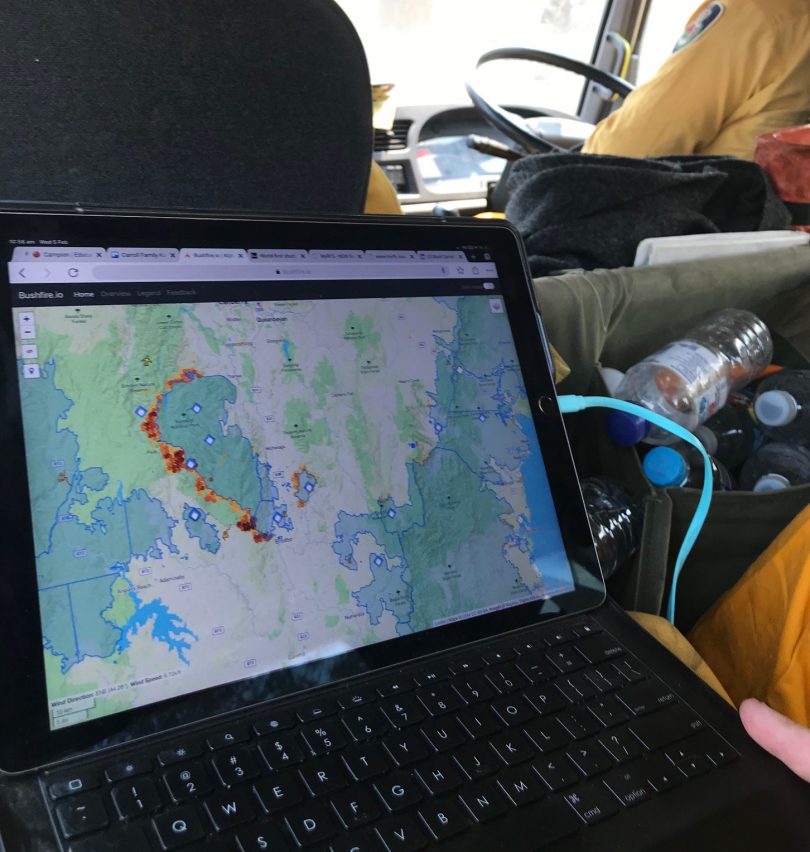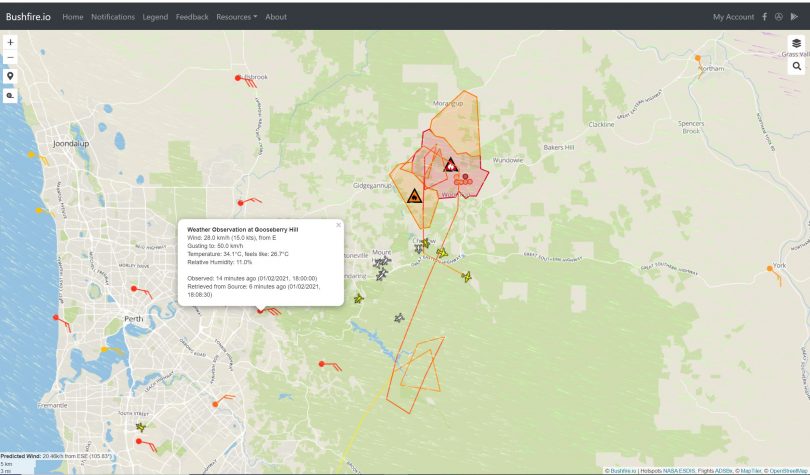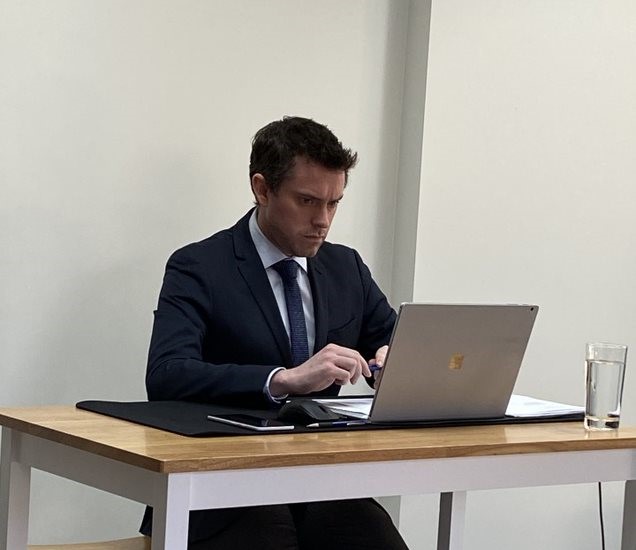
The Bushfire.io website being used in the field by firefighters. Photo: Supplied.
The Canberra startup behind a website forged in the intensity of the 2019-2020 bushfires that became a national sensation is now on the hunt for capital to make it commercially viable while retaining its original community service mission.
The popularity of Bushfire.io during the Black Summer spread like the wildfires it tracked, alerting communities across the nation to the location of outbreaks and providing information on one site that helped people make decisions and gave comfort during the crisis.
Co-founder, director and NSW Rural Fire Service volunteer Mark Carroll says his partner, Tristan Morris, initially created the site out of necessity when he needed to navigate his way back to Canberra through the fires from the NSW South Coast, combining data from NSW and Victorian fire apps with traffic and weather data.
“I was on the back of a fire truck and thought, ‘Wow, this is actually pretty cool – integrating the data and putting it all in one place,” says Mark.
They later added more data including wind and real-time weather observations, satellite-identified hotspots, and the areas where firefighting aircraft were operating, then expanded to other states to provide a truly national picture.
They see further applications for other national disasters, not just bushfires.
By the time of the Orroral Valley bushfire in the ACT, in late January 2020, the website had garnered 160,000 unique users, and it was apparent it had become an essential community resource. It had the development potential that required a company structure.
The most recent summer was mild on Australia’s east coast, but it was a scorcher in Western Australia. When the Wooroloo bushfire hit in February 2021, there were more than 450,000 unique users and 100,000 app downloads.

A screenshot of the Bushfire.io website during the Wooroloo fires in Western Australia in February 2021. Image: Supplied.
Mark says there was incredible feedback from the Wooroloo community about how valuable the website was, and the startup is now trying to come up with a business model that allows it to stay true to the original social objectives.
Continuing to finance it out of their pockets through their own consultancies is not sustainable, and the company is now focused on developing commercial products from the public platform, tailor-made for businesses wanting to manage their risk of exposure to fire and other natural disasters.
It already has one paying customer for a product called Firefeed, designed for larger companies and government agencies which have their own geospatial capabilities, and that allows them to identify fire events near their facilities.
Another idea is to provide a customised version of Bushfire.io to customers that only they can access.
While the basic platform would still remain open to the community, the company could provide paid premium services or a pro version that would provide features for displaying lightning strikes, weather radar, smoke prediction and recent fire history.
Tristan gave evidence to the recent Royal Commission into National Natural Disaster Arrangements (Bushfires Royal Commission) which recommended the development of a national bushfire app, such as Bushfire.io.
“We are providing that national capability to be able to identify fires, and then providing a bunch of additional data to help people make decisions about what they do in the event of fire,” says Mark.
“It’s providing a much richer picture.”
He says they would be happy to work with government to use their platform, but there are roles that apps such as theirs can play in addition to what government is doing.
They are more likely to complement the work of agencies, says Mark.

Tristan Morris created Bushfire.io out of necessity during the Black Summer. Photo: Supplied.
He says government is getting better at using data to resolve problems, but that requires thinking from the customer or user perspective not from the institutional perspective.
“With Bushfire.io we started out from what do firefighters need on a single map for their situational awareness in a fire event, and then went and got the data and put it together in a way that was very easy for them to interpret and absorb,” says Mark.
While the company is focused on the Australian market, it does see potential for its services in other countries.
“Fires are getting worse across the globe,” says Mark. “We’re seeing areas that traditionally haven’t burned and where fires haven’t been an issue that are now becoming an issue.
“This sort of capability is only going to become more valuable and required as we move on.”
He says strategically Canberra and its proximity to government offers a great location to grow the business, but the city is also developing an ecosystem that promotes innovation and encourages startups.
“We see a real opportunity for Canberra to be one of those bright shining lights on the map that is showcasing innovation and is really turning out very valuable capability,” says Mark.
Being able to plug into organisations such as the Canberra Innovation Network and Canberra Angels – which introduces companies such as theirs to investors – is key.
“The ability to work with government and complement or assist some of those efforts is pretty valuable, but that entrepreneurial ecosystem and vibe is coming out in Canberra on a day-to-day basis as well,” says Mark.
Original Article published by Ian Bushnell on The RiotACT.


What's Your Opinion?